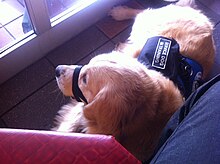



Aseizure response dog (SRD) (also known as seizure dog) is a dog demonstrating specific assisting behaviour during or immediately after a person's epileptic seizure or other seizure.[1][2] When reliably trained such dogs can serve as service dogs for people with epilepsy.[3]
Tasks for seizure dogs may include, but are not limited to:[4][5][6][7]
A dog demonstrating specific behaviour prior to a person's epileptic seizure is also referred to as seizure alert dog (SAD).[2][8][9] Reports suggest that some dogs can be trained to anticipate epileptic seizures.[3][8] However, this ability has been questioned.[10][11][12]
Seizure response and seizure alerting behaviour may spontaneously develop in dogs living with children and adults with epilepsy.[1][2][9]
{{cite journal}}: CS1 maint: multiple names: authors list (link) CS1 maint: numeric names: authors list (link)
{{cite journal}}: CS1 maint: multiple names: authors list (link) CS1 maint: numeric names: authors list (link)
{{cite journal}}: CS1 maint: multiple names: authors list (link) CS1 maint: numeric names: authors list (link)
{{cite journal}}: CS1 maint: multiple names: authors list (link) CS1 maint: numeric names: authors list (link)